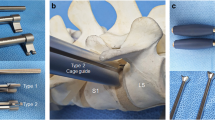Abstract
Purpose
Interbody spine fusion with cages was first described by Bagby and has been performed for a long time now in a variety of different conditions. We developed a percutaneous endoscopic lumbar fusion technique based on the principles of Kambin and an original titanium cage.
Materials and methods
From 2004 to 2010, 57 patients were operated on, 17 patients were male with a mean age of 50.29 years (range 34–71 years) and 40 were female with a mean age of 57.42 years (29–90 years). Nineteen patients had a previous operation. Patients were operated on under local anaesthesia in the prone position under image intensifier and a transforaminal percutaneous endoscopic approach.
Results
Fifty cases had a bilateral cage through a bilateral endoscopic approach, and seven cases had a unilateral endoscopic approach only; of those, three cases had only one cage. Eleven patients had a contemporary posterior plate fixation at the same time of the endoscopic cage fusion. Eight patients had a postoperative radicular pain with paresthesias. Asymptomatic migration of the cages occurred in two cases and symptomatic migration requiring a conventional secondary reoperation in 13 cases after a mean delay of eight months (range three to 36 months). The mean ODI after two years or more was 34.3 % (initial ODI 69.4 %).
Conclusions
The technique was introduced in our practice to take care of difficult or grave co-morbidity patients, and some patients had excellent lasting results following a very short procedure and hospital stay. However, given the 36 % complication rate in this series, we do not recommend it unless decisive technical improvements are made.
Similar content being viewed by others
References
Bagby GW (1988) Arthrodesis by the distraction-compression method using a stainless steel implant. Orthopedics 11(6):931–934
Wang MY (2013) Improvement of sagittal balance and lumbar lordosis following less invasive adult spinal deformity surgery with expandable cages and percutaneous instrumentation. J Neurosurg Spine 18(1):4–12. doi:10.3171/2012.9.SPINE111081
Berjano P, Lamartina C (2013) Far lateral approaches (XLIF) in adult scoliosis. Eur Spine J 22(Suppl 2):242–253. doi:10.1007/s00586-012-2426-5
Park Y, Ha JW (2007) Comparison of one-level posterior lumbar interbody fusion performed with a minimally invasive approach or a traditional open approach. Spine (Phila Pa 1976) 32(5):537–543. doi:10.1097/01.brs.0000256473.49791.f4
Eck JC, Hodges S, Humphreys SC (2007) Minimally invasive lumbar spinal fusion. J Am Acad Orthop Surg 15(6):321–329
Kambin P (2003) Arthroscopic microdiscectomy. Spine J 3(3 Suppl):60S–64S
Kim CW, Siemionow K, Anderson DG, Phillips FM (2011) The current state of minimally invasive spine surgery. J Bone Joint Surg Am 93(6):582–596
Yeung AT, Yeung CA (2006) In-vivo endoscopic visualization of patho-anatomy in painful degenerative conditions of the lumbar spine. Surg Technol Int 15:243–256
Martin CT, Witham TF, Kebaish KM (2011) Sacropelvic fixation: two case reports of a new percutaneous technique. Spine (Phila Pa 1976) 36(9):E618–E621. doi:10.1097/BRS.0b013e3181f79aba
Lee JC, Jang HD, Shin BJ (2012) Learning curve and clinical outcomes of minimally invasive transforaminal lumbar interbody fusion: our experience in 86 consecutive cases. Spine (Phila Pa 1976) 37(18):1548–1557. doi:10.1097/BRS.0b013e318252d44b
Kraus MD, Krischak G, Keppler P, Gebhard FT, Schuetz UH (2010) Can computer-assisted surgery reduce the effective dose for spinal fusion and sacroiliac screw insertion? Clin Orthop Relat Res 468(9):2419–2429. doi:10.1007/s11999-010-1393-6
Schwender JD, Holly LT, Rouben DP, Foley KT (2005) Minimally invasive transforaminal lumbar interbody fusion (TLIF): technical feasibility and initial results. J Spinal Disord Tech 18(Suppl):S1–S6
Shim JH, Kim WS, Kim JH, Kim DH, Hwang JH, Park CK (2011) Comparison of instrumented posterolateral fusion versus percutaneous pedicle screw fixation combined with anterior lumbar interbody fusion in elderly patients with L5-S1 isthmic spondylolisthesis and foraminal stenosis. J Neurosurg Spine 15(3):311–319. doi:10.3171/2011.4.SPINE10653
Isaacs RE, Hyde J, Goodrich JA, Rodgers WB, Phillips FM (2010) A prospective, nonrandomized, multicenter evaluation of extreme lateral interbody fusion for the treatment of adult degenerative scoliosis: perioperative outcomes and complications. Spine (Phila Pa 1976) 35(26 Suppl):S322–S330. doi:10.1097/BRS.0b013e3182022e04
Anand N, Rosemann R, Khalsa B, Baron EM (2010) Mid-term to long-term clinical and functional outcomes of minimally invasive correction and fusion for adults with scoliosis. Neurosurg Focus 28(3):E6. doi:10.3171/2010.1.FOCUS09278
Anand N, Baron EM, Thaiyananthan G, Khalsa K, Goldstein TB (2008) Minimally invasive multilevel percutaneous correction and fusion for adult lumbar degenerative scoliosis: a technique and feasibility study. J Spinal Disord Tech 21(7):459–467. doi:10.1097/BSD.0b013e318167b06b
Scheufler KM, Dohmen H, Vougioukas VI (2007) Percutaneous transforaminal lumbar interbody fusion for the treatment of degenerative lumbar instability. Neurosurgery 60(4 Suppl 2):203–212. doi:10.1227/01.NEU.0000255388.03088.B7, discussion 212–203
Lee SH, Choi WG, Lim SR, Kang HY, Shin SW (2004) Minimally invasive anterior lumbar interbody fusion followed by percutaneous pedicle screw fixation for isthmic spondylolisthesis. Spine J 4(6):644–649. doi:10.1016/j.spinee.2004.04.012
Ahn Y, Lee SH, Park WM, Lee HY, Shin SW, Kang HY (2004) Percutaneous endoscopic lumbar discectomy for recurrent disc herniation: surgical technique, outcome, and prognostic factors of 43 consecutive cases. Spine (Phila Pa 1976) 29(16):E326–E332
Uribe JS, Vale FL, Dakwar E (2010) Electromyographic monitoring and its anatomical implications in minimally invasive spine surgery. Spine (Phila Pa 1976) 35(26 Suppl):S368–S374. doi:10.1097/BRS.0b013e3182027976
Kim S, Chung J, Yi BJ, Kim YS (2010) An assistive image-guided surgical robot system using O-arm fluoroscopy for pedicle screw insertion: preliminary and cadaveric study. Neurosurgery 67(6):1757–1767. doi:10.1227/NEU.0b013e3181fa7e42, discussion 1767
Wang Y, Le DQ, Li H, Wang M, Bunger CE (2011) Navigated percutaneous lumbosacral interbody fusion: a feasibility study with three-dimensional surgical simulation and cadaveric experiment. Spine (Phila Pa 1976) 36(16):E1105–E1111. doi:10.1097/BRS.0b013e3181fc22d4
Yao N, Wang W, Liu Y (2011) Percutaneous endoscopic lumbar discectomy and interbody fusion with B-Twin expandable spinal spacer. Arch Orthop Trauma Surg 131(6):791–796. doi:10.1007/s00402-010-1222-0
Author information
Authors and Affiliations
Corresponding author
Rights and permissions
About this article
Cite this article
Jacquot, F., Gastambide, D. Percutaneous endoscopic transforaminal lumbar interbody fusion: is it worth it?. International Orthopaedics (SICOT) 37, 1507–1510 (2013). https://doi.org/10.1007/s00264-013-1905-6
Received:
Accepted:
Published:
Issue Date:
DOI: https://doi.org/10.1007/s00264-013-1905-6




